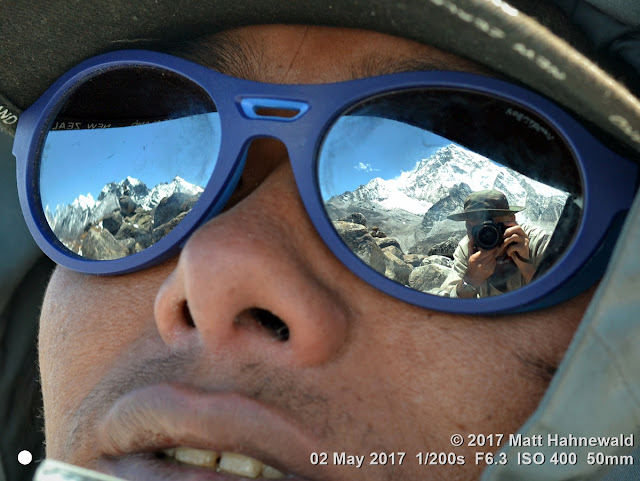Mt. Everest, aka Sagarmāthā in Nepal, is the planet’s highest mountain. Its peak is 8,848 m above sea level. Mt. Everest attracts many climbers, some of them highly experienced mountaineers. While not posing substantial technical climbing challenges on the southern standard route, Mt. Everest
presents dangers such as altitude sickness, weather, and wind, as well as significant hazards from avalanches and the Khumbu Icefall. As of 2016 CE there are well over 200 corpses on the mountain, some of which serve as landmarks. The 2017 CE Mt. Everest summit season kicked off to a big start, set to be
the largest climbing season in the modern history of the mountain with 365 people on 39 teams from around the world, just on the south/Nepali side.
(South) Everest Base Camp is in Nepal at an altitude of c. 5,365 m and is a rudimentary camp site on Mt. Everest that is used by mountain climbers during their ascent and descent. Supplies are shipped to the Everest Base Camp by Sherpas or porters, and with the help of animals, usually yaks. It has become a "Global Village" for about two months every year as hundreds of people from around the world undertake expeditions to the mountain.
The 14-day Everest Base Camp Trek is one of the most popular trekking routes in the Himalayas and is visited by many trekkers each year. Trekkers usually fly from Kathmandu to Lukla to save time. There are no roads from Kathmandu to Lukla and as a result, the only method of transporting large and heavy goods is by STOL plane. From Lukla, climbers trek upward to the Sherpa capital of Namche Bazaar, c. 3,440 m above sea level, following the valley of the Dudh Kosi river. It takes about two days to reach the village, which is a central hub of the area. Typically at this point, climbers allow a day of rest or do a day trip to Everest View Point (c. 3,860 m above sea level) for acclimatization. They then trek another two days to Dingboche (c. 4,260 m above sea level), before resting for another day for further acclimatization. Another two days takes them to Everest Base Camp (c. 5,365 m above sea level) via Gorak Shep (c. 5,140 m above sea level).
The 14-day Everest Base Camp Trek is one of the most popular trekking routes in the Himalayas and is visited by many trekkers each year. Trekkers usually fly from Kathmandu to Lukla to save time. There are no roads from Kathmandu to Lukla and as a result, the only method of transporting large and heavy goods is by STOL plane. From Lukla, climbers trek upward to the Sherpa capital of Namche Bazaar, c. 3,440 m above sea level, following the valley of the Dudh Kosi river. It takes about two days to reach the village, which is a central hub of the area. Typically at this point, climbers allow a day of rest or do a day trip to Everest View Point (c. 3,860 m above sea level) for acclimatization. They then trek another two days to Dingboche (c. 4,260 m above sea level), before resting for another day for further acclimatization. Another two days takes them to Everest Base Camp (c. 5,365 m above sea level) via Gorak Shep (c. 5,140 m above sea level).
The Sherpas are a Buddhist ethnic group from the most mountainous region of Nepal, the Himalayas, and most Sherpa people live in Nepal's eastern regions. Sherpas are highly regarded as elite mountaineers and experts in their local area. They were immeasurably valuable to early explorers of the Himalayan region, serving as guides at the extreme altitudes of the peaks and passes in the region, particularly for expeditions
to climb Mt. Everest. Today, the term sherpa is often used to refer to almost any trekking or climbing guide hired for trekking or mountaineering expeditions in the Himalayas, regardless of their ethnicity.
Namche Bazaar is a famous and remote mountain village in the Solukhumbu District; it is located within the Khumbu area at an altitude of c. 3,440 m. It is the main trading center and hub for the Khumbu region. Namche Bazaar is also popular with trekkers in the Khumbu region, especially for altitude acclimatization, and is the gateway to the high Himalayas. On Saturday mornings, a lively weekly market is held in the centre of the village where local people from the surrounding valleys spread out their agricultural products, and traders from Kathmandu sell their
goods carried by yak trains or human porters into Namche Bazaar.
High-res portrait photographs with full exif data, precise geotags and technical details in Matt Hahnewald's
Flickr Album 2017-05a Trekking to Everest Base Camp
Flickr Album 2016-05a Circling the Mighty Annapurnas
Flickr Album 2015-04c Resisting Nepalese Temptations
Flickr Album 2014-11a Bribing Sadhus in Nepal
Flickr Album 2017-05a Trekking to Everest Base Camp
Flickr Album 2016-05a Circling the Mighty Annapurnas
Flickr Album 2015-04c Resisting Nepalese Temptations
Flickr Album 2014-11a Bribing Sadhus in Nepal














2 comments:
Beautiful portraits and helpful information. Looking forward to this experience.Thanks for sharing this :)
Thanks for commenting. I'm glad you liked it.
Greets from Ontario.
Post a Comment